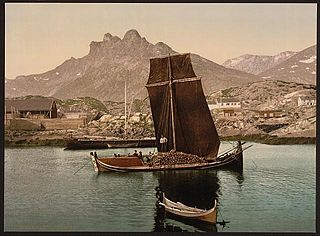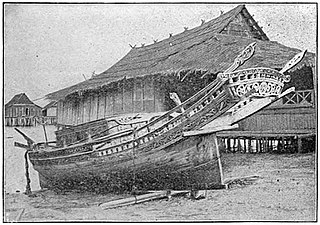
A rudder is a primary control surface used to steer a ship, boat, submarine, hovercraft, aircraft, or other conveyance that moves through a fluid medium. On an aircraft the rudder is used primarily to counter adverse yaw and p-factor and is not the primary control used to turn the airplane. A rudder operates by redirecting the fluid past the hull (watercraft) or fuselage, thus imparting a turning or yawing motion to the craft. In basic form, a rudder is a flat plane or sheet of material attached with hinges to the craft's stern, tail, or after end. Often rudders are shaped so as to minimize hydrodynamic or aerodynamic drag. On simple watercraft, a tiller—essentially, a stick or pole acting as a lever arm—may be attached to the top of the rudder to allow it to be turned by a helmsman. In larger vessels, cables, pushrods, or hydraulics may be used to link rudders to steering wheels. In typical aircraft, the rudder is operated by pedals via mechanical linkages or hydraulics.

Colin Archer was a Norwegian naval architect and shipbuilder known for his seaworthy pilot and rescue boats and the larger sailing and polar ships. His most famous ship is the Fram, used on both in Fridtjof Nansen's and Roald Amundsen's polar expeditions. He was born at Tollerodden in Larvik, Norway, where he also had his own house built and his boatyard.

Clinker built is a method of boat building where the edges of hull planks overlap each other originating in Scandinavia. Where necessary in larger craft, shorter planks can be joined end to end into a longer strake or hull plank. The technique developed in northern Europe and was successfully used by the Anglo-Saxons, Frisians, Scandinavians, and typical for the Hanseatic cog. A contrasting method, where plank edges are butted smoothly seam to seam, is known as carvel construction.

On a vessel's hull, a strake is a longitudinal course of planking or plating which runs from the boat's stempost to the sternpost or transom. The garboard strakes are the two immediately adjacent to the keel on each side.
Thames Measurement, also known as Thames Tonnage, is a system for measuring ships and boats. It was created in 1855 as a variation of Builder's Old Measurement by the Royal Thames Yacht Club, and was designed for small vessels, such as yachts. It was originally used for calculating the port dues for yachts; the formula was also used in some early handicapping systems for yacht racing.

Length between perpendiculars is the length of a ship along the summer load line from the forward surface of the stem, or main bow perpendicular member, to the after surface of the sternpost, or main stern perpendicular member. When there is no sternpost, the centerline axis of the rudder stock is used as the aft end of the length between perpendiculars.

The draft or draught of a ship's hull is the vertical distance between the waterline and the bottom of the hull (keel). The draught of the vessel is the maximum depth of any part of the vessel, including appendages such as rudders, propellers and drop keels if deployed. Draft determines the minimum depth of water a ship or boat can safely navigate. The related term air draft is the maximum height of any part of the vessel above the water.

The Nordland boat, is a type of fishing boat that has been used for centuries in northern counties of Nordland, Troms and Finnmark of Norway and derives its name from Nordland county where it has a long history. It has dominated the Lofoten and Vesterålen islands fishing industry for centuries and is closely related to the old Viking longships.

The stern is the back or aft-most part of a ship or boat, technically defined as the area built up over the sternpost, extending upwards from the counter rail to the taffrail. The stern lies opposite the bow, the foremost part of a ship. Originally, the term only referred to the aft port section of the ship, but eventually came to refer to the entire back of a vessel. The stern end of a ship is indicated with a white navigation light at night.

The Edna E. Lockwood is a Chesapeake Bay bugeye, the last working oyster boat of her kind. She is located at the Chesapeake Bay Maritime Museum in Saint Michaels, Maryland. She was built in 1889 at Tilghman Island, Maryland by John B. Harrison and is of nine-log construction, similar to the smaller log canoe, and was launched on October 5, 1889 for Daniel Haddaway, at a cost of $2,200. She worked for at least seven sets of owners from 1899 until 1967, and was then sailed as a yacht until donated to the museum in 1973. The museum undertook an extensive restoration of the Lockwood from 1975 through 1979, which restored the bugeye to its 1910 appearance with the "patent stern" that had been added sometime prior to that year. She is the last bugeye retaining the sailing rig and working appearance of the type. Her length is 53.5 feet (16.3 m), with a 15.25 feet (4.65 m) beam and a draft of 2.58 feet (0.79 m) with the centerboard up, and a maximum sail area of approximately 1700 square feet.

The term lambo or lamba refer to two types of traditional boats from Indonesia.

The Sparrow-Hawk was a 'small pinnace' similar to the full-rigged pinnace Virginia that sailed for the English Colonies in June 1626. She is the earliest ship to participate in the first decades of English settlement in the New World to have survived to the present day.

Lepa, also known as lipa or lepa-lepa, are indigenous ships of the Sama-Bajau people in the Philippines and Malaysia. They were traditionally used as houseboats by the seagoing Sama Dilaut. Since most Sama have abandoned exclusive sea-living, modern lepa are instead used as fishing boats and cargo vessels.
A lerret is type of fishing boat designed for use off the Chesil Beach in Dorset. It was an open clinker-built rowing boat about 16 feet long with a beam of about 5–6 feet, rowed by 2 or 3 pairs of rowers. To facilitate launching and beaching on the steep shingle of Chesil Beach, the stern was sharp with a high sternpost and the bottom of the craft was flat. The design dates back to the 17th century and the name is a contraction of Lady of Loretto – the first boat of this type built by a local ship's master who had formerly traded with Italy and named it after the shrine at Loretto. There were about 50 at the end of the 19th century but, in 2010, there were only about 4 left so a new one was built to preserve the type.

Lis-alis is a type of traditional boat of Madura, Indonesia. Lis-alis usually present in canals that provide salt evaporation service in southern part of Madura and around Surabaya. Until the present, lis-alis remained overwhelmingly popular as a fishing craft in Bangkalan and Sukolilo, while a larger version, the kroman, has been used in this area for at least a century for inshore transport work.

Benawa or banawa is a type of ship from Gowa, an old principality in the southwest corner of Sulawesi, Indonesia. The earliest record of this vessel is from Hikayat Banjar, which has been written gradually from 14th-17th century. In the present, the type is already extinct; pelari and paduwakan, vessels with similar hull, have taken its place.

Palari is a type of Indonesian sailing vessel from South Sulawesi. It was mainly used by the people of Ara and Lemo Lemo, for transporting goods and people. This vessel is rigged with pinisi rig, which often makes it better known as "Pinisi" instead of its name. In Singapore, palari is known as "Makassartrader".

Pajala is a type of traditional perahu from western South Sulawesi, Indonesia. It is used mainly for fishing, but in the present it's a Bugis/Makassar name for small to medium-sized boat hull.

Orembai or Arombai is a type of plank boat from the Maluku Islands of Eastern Indonesia. It is mainly used for fishing and transport. This vessel is used as far as Batavia, where in the 17th century it became popular to go out "orembaaien" on an evening rowing on the river or city canals.

Lancang is a type of sailing ship from Maritime Southeast Asia. It is used as warship, lighter, and as royal ship, particularly used by the people of Sumatran east coast, but can also be found in the coast of Kalimantan.

















